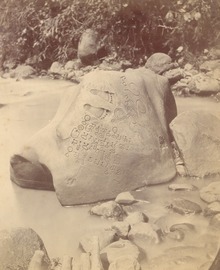Ciaruteun inscription

Ciaruteun inscription on its original location, circa 1900
|
|
| Material | Stone |
|---|---|
| Size | 2 by 1.5 meters |
| Writing | Pallava script in Sanskrit And Javanese Script |
| Created | early 5th century |
| Discovered | Ciaruteun river, Ciaruteun Ilir village, Cibungbulang district, Bogor Regency, West Java, Indonesia |
| Present location | in situ |
Ciaruteun inscription (Indonesian: Prasasti Ciaruteun) also written Ciarutön or also known as Ciampea inscription is a 5th-century stone inscription discovered on the riverbed of Ciaruteun River, a tributary of Cisadane River, not far from Bogor, West Java, Indonesia. The inscription is dated from the Tarumanagara kingdom period, one of the earliest Hindu kingdom in Indonesian history. The inscription documents an edict of King Purnawarman, in which he declared himself the ruler of Tarumanagara.
Ciaruteun inscription is located in Ciaruteun Ilir village, Cibungbulang district, Bogor Regency; on coordinate 6°31’23,6” Latitude dan 106°41’28,2” Longitude. This location is approximately 19 kilometres Northwest of Bogor city center. The location is a small hill (Sunda: pasir) which is the confluence of three rivers: Cisadane, Cianten, and Ciaruteun. Until 19th century, the location is reported as part of Pasir Muara, which included into the private land of Tjampéa (Ciampea), although today it is part of Cibungbulang district.
The inscription was inscribed on a huge natural stone locally known as batu kali (river stone) weighted eight tonnes, and measures 200 centimetres by 150 centimetres.
In 1863 Dutch East Indies, a huge boulder of inscribed stone was spotted near Tjampea (Ciampea) not far from Buitenzorg (Bogor). The stone inscription was discovered on the river bed of Tjiaroeteun river, a tributary of Cisadane River. It is today known as Ciaruteun inscription, dated from the 5th century, written in Vengi letters (used in the Indian Pallava period) and in Sanskrit language. This is the earliest inscription that clearly mentioned the kingdom's name — "Tarumanagara". The inscription reports Purnawarman as the most famous king of Tarumanagara. In the same year, the discovery of this inscription was reported to the Bataaviasch Genootschap van Kunsten en Wetenschappen (today National Museum of Indonesia) in Batavia. Because of the large flood in 1893, the stone was carried away several meters and was slightly tilted. Then in 1903, the inscription was restored to its original position.
...
Wikipedia
